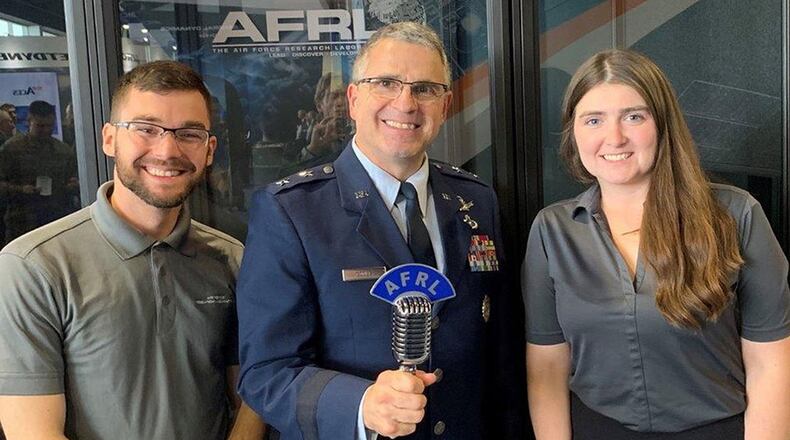There were about 150 exhibitor booths set up during the convention, but AFRL’s Lab Life podcast booth was a unique feature at the event.
“We had a lot of exciting guests join us in the podcast booth,” said Michele Miller, a senior strategic communications specialist with AFRL’s Corporate Communications division. “Acting Secretary of the Air Force Matthew Donovan and other Air Force leaders share what excites them most about the future of Air Force science and technology in this episode of Lab Life.”
“Getting back to cutting-edge development of aircraft and other technologies, sort of back to our heyday in the ‘50s and ‘60s where we had the Century Series fighter development,” said Matthew Donovan, then acting secretary of the Air Force. “In a period of 15 years, we prototyped 11 new fighter aircraft and fielded six of them. How do we return to that?”
Donovan also shares a message for the next generation of Airmen: “Get on board and hold on because we’re moving fast. It is that innovation and that grit and tenacity of our Airmen who just want to be part of that amazing technology and make a difference for our nation.”
Gen. Arnold W. Bunch Jr., commander of Air Force Materiel Command, leads more than 80,000 Airmen involved with installation and mission support, discovery and development, test and evaluation, life cycle management services and sustainment of virtually every major Air Force weapon system.
“Our ability to do science and technology in a rapid manner and get technologies fielded faster is more important now than it ever has been,” Bunch said. “If we don’t do those S&T activities the right way, up front and early, and stay involved, we won’t be able to compete, and we won’t be able to give our most valued treasure – America’s sons and daughters, a competitive edge when we send them into harm’s way, and that’s really our mission today.”
“If you really want an edge, you have to have good technology,” said Lt. Gen. Robert McMurry, commander, Air Force Lifecycle Management Center. “We have to keep pushing that edge. The things that I’m looking at right now that I really think are exploding are data analytics, artificial intelligence, potentially quantum, and some material science.”
“I have the great honor of running the Air Force’s Tech Company, which is really what doing acquisition is,” said Dr. Will Roper, assistant secretary of the Air Force for Acquisition, Technology and Logistics.
“One area I’ve seen a tremendous change is our ability to be a digital service. We usually think of government as being bad at software, and there are a lot of reasons to think that if you look backward,” Roper said. “But looking forward, we’ve had over 30 agile organizations that share something in common … they’re using commercial agile software development practices. They are writing code in weeks not months or years. That code is changing the way the Air Force can fight and win – not in the far future, but right now.
“The Air Force has also done great at starting to become a commercial investor,” Roper said. “Organizations like AFWERX and the Small Business Innovation Research Program are now doing Pitch Days where they have industry, small businesses and tech startups come in and pitch an idea and they leave with money that day to go ahead and start working that day with the warfighter, just as if they were working with a private investor. There is a huge potential to tap commercial resources, commercial capital to do defense work, if we just think of ourselves as an incubator and catalyst for research and not just a researcher per se.
“Risk taking is still something that I’d like to see us get to another level with,” Roper added. “From my view, we’ve got to be a moon-shot organization. We have to take some big chances to have big wins and that means that we’re going to have big failures. The future is either experienced or made and if we don’t take risks, we’re going to experience someone else’s future. I’d rather make it.”
“I’m really excited about the science and technology strategy for 2030 and beyond. It has opened up an opportunity for the entire Air Force science and technology enterprise to reevaluate and in some sense, reinvent ourselves in ways I’m confident we’re going to be able to improve our efficacy in delivering our technology to the warfighter in the future,” said Maj. Gen. William Cooley, AFRL commander.
“Probably the strongest and most powerful weapon that we have in the United States is competition,” Cooley said. “We see that in our day-to-day lives in terms of what the commercial industry brings, constantly refreshing itself, bringing in new capability. The military has to have ideas competing in such a way that we can bring the best and the brightest.”
To hear these senior leader comments and others, tune in to “Lab Life,” via multiple ways:
• Stream or download at the Defense Visual Information Distribution Service website at https://www.dvidshub.net/audio/61052/lab-life-episode-15-live-2019-air-force-association-air-space-and-cyber-conference
• Search for “Lab Life” on Apple podcasts or through a favorite podcast application
• Stream through the Air Force Materiel Command mobile app on AF Connect
• Lab Life on Apple podcasts is available at https://itunes.apple.com/us/podcast/id1455263736
• Listen on Stitcher by visiting https://www.stitcher.com/podcast/air-force-materiel-command/lab-life
• Listen on Spotify at https://open.spotify.com/show/3WuwkfgDRIiX2EVh0odzBR
About the Author
